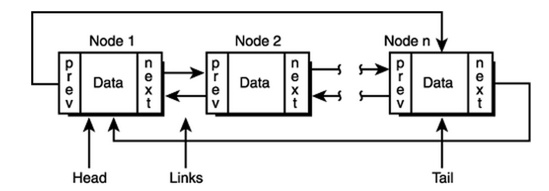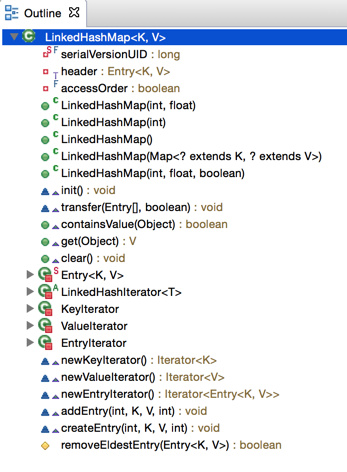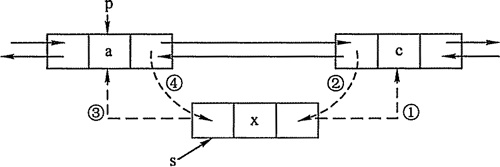Java LinkedHashMap源码解析,linkedhashmap源码
Java LinkedHashMap源码解析,linkedhashmap源码
上周把HashMap、TreeMap这两个Map体系中比较有代表性的类介绍完了,大家应该也能体会到,如果该类所对应的数据结构与算法掌握好了,再看这些类的源码真是太简单不过了。
其次,我希望大家能够触类旁通,比如我们已经掌握了HashMap的原理,我们可以推知HashSet的内部实现
HashSet 内部用一个HashMap对象存储数据,更具体些,只用到了key,value全部为一dummy对象。
HashSet这个类太简单了,我不打算单独写文章介绍。今天介绍个比较实用的类——LinkedHashMap。
签名
public class LinkedHashMap<K,V>
extends HashMap<K,V>
implements Map<K,V>
可以看到,LinkedHashMap是HashMap的一子类,它根据自身的特性修改了HashMap的内部某些方法的实现,要想知道LinkedHashMap具体修改了哪些方法,就需要了解LinkedHashMap的设计原理了。
设计原理
双向链表
LinkedHashMap是key键有序的HashMap的一种实现。它除了使用哈希表这个数据结构,使用双向链表来保证key的顺序
双向链表
双向链表算是个很常见的数据结构,上图中的头节点的prev、尾节点的next指向null,双向链表还有一种变种,见下图

可以看到,这种链表把首尾节点相连,形成一个环。
LinkedHashMap中采用的这种环型双向链表,环型双向链表的用途比较多,感兴趣可以看这里:
- http://stackoverflow.com/questions/3589772/why-exactly-do-we-need-a-circular-linked-list-singly-or-doubly-data-structur
双向链表这种数据结构,最关键的是保证在增加节点、删除节点时不要断链,后面在分析LinkedHashMap具体代码时会具体介绍,这里就不赘述了。
LinkedHashMap 特点
一般来说,如果需要使用的Map中的key无序,选择HashMap;如果要求key有序,则选择TreeMap。
但是选择TreeMap就会有性能问题,因为TreeMap的get操作的时间复杂度是O(log(n))的,相比于HashMap的O(1)还是差不少的,LinkedHashMap的出现就是为了平衡这些因素,使得
能够以
O(1)时间复杂度增加查找元素,又能够保证key的有序性
此外,LinkedHashMap提供了两种key的顺序:
- 访问顺序(access order)。非常实用,可以使用这种顺序实现LRU(Least Recently Used)缓存
- 插入顺序(insertion orde)。同一key的多次插入,并不会影响其顺序
源码分析
首先打开eclipse的outline面版看看LinkedHashMap里面有那些成员

key的有序性而重写了HashMap中的部分方法。
构造函数
//accessOrder为true表示该LinkedHashMap的key为访问顺序
//accessOrder为false表示该LinkedHashMap的key为插入顺序
private final boolean accessOrder;
public LinkedHashMap(int initialCapacity, float loadFactor) {
super(initialCapacity, loadFactor);
//默认为false,也就是插入顺序
accessOrder = false;
}
public LinkedHashMap(int initialCapacity) {
super(initialCapacity);
accessOrder = false;
}
public LinkedHashMap() {
super();
accessOrder = false;
}
public LinkedHashMap(Map<? extends K, ? extends V> m) {
super(m);
accessOrder = false;
}
public LinkedHashMap(int initialCapacity,
float loadFactor,
boolean accessOrder) {
super(initialCapacity, loadFactor);
this.accessOrder = accessOrder;
}
/**
* Called by superclass constructors and pseudoconstructors (clone,
* readObject) before any entries are inserted into the map. Initializes
* the chain.
*/
@Override
void init() {
header = new Entry<>(-1, null, null, null);
//通过这里可以看出,LinkedHashMap采用的是环型的双向链表
header.before = header.after = header;
}
LinkedHashMap.Entry
private static class Entry<K,V> extends HashMap.Entry<K,V> {
// These fields comprise the doubly linked list used for iteration.
//每个节点包含两个指针,指向前继节点与后继节点
Entry<K,V> before, after;
Entry(int hash, K key, V value, HashMap.Entry<K,V> next) {
super(hash, key, value, next);
}
/**
* Removes this entry from the linked list.
*/
//删除一个节点时,需要把
//1. 前继节点的后继指针 指向 要删除节点的后继节点
//2. 后继节点的前继指针 指向 要删除节点的前继节点
private void remove() {
before.after = after;
after.before = before;
}
/**
* Inserts this entry before the specified existing entry in the list.
*/
//在某节点前插入节点
private void addBefore(Entry<K,V> existingEntry) {
after = existingEntry;
before = existingEntry.before;
before.after = this;
after.before = this;
}
/**
* This method is invoked by the superclass whenever the value
* of a pre-existing entry is read by Map.get or modified by Map.set.
* If the enclosing Map is access-ordered, it moves the entry
* to the end of the list; otherwise, it does nothing.
*/
void recordAccess(HashMap<K,V> m) {
LinkedHashMap<K,V> lm = (LinkedHashMap<K,V>)m;
// 如果需要key的访问顺序,需要把
// 当前访问的节点删除,并把它插入到双向链表的起始位置
if (lm.accessOrder) {
lm.modCount++;
remove();
addBefore(lm.header);
}
}
void recordRemoval(HashMap<K,V> m) {
remove();
}
}
为了更形象表示双向链表是如何删除、增加节点,下面用代码加图示的方式
删除节点

private void remove() {
before.after = after; //相当于上图中的操作 1
after.before = before; //相当于上图中的操作 3
}
增加节点

private void addBefore(Entry<K,V> existingEntry) {
after = existingEntry; //相当于上图中的操作 1
before = existingEntry.before; //相当于上图中的操作 3
before.after = this; //相当于上图中的操作 4
after.before = this; //相当于上图中的操作 2
}
知道了增加节点的原理,下面看看LinkedHashMap的代码是怎么实现put方法的
/**
* This override alters behavior of superclass put method. It causes newly
* allocated entry to get inserted at the end of the linked list and
* removes the eldest entry if appropriate.
*/
void addEntry(int hash, K key, V value, int bucketIndex) {
super.addEntry(hash, key, value, bucketIndex);
// Remove eldest entry if instructed
Entry<K,V> eldest = header.after;
//如果有必要移除最老的节点,那么就移除。LinkedHashMap默认removeEldestEntry总是返回false
//也就是这里if里面的语句永远不会执行
//这里removeEldestEntry主要是给LinkedHashMap的子类留下的一个钩子
//子类完全可以根据自己的需要重写removeEldestEntry,后面我会举个现实中的例子
用户点评